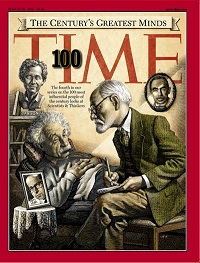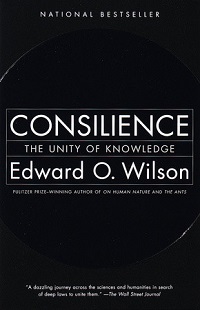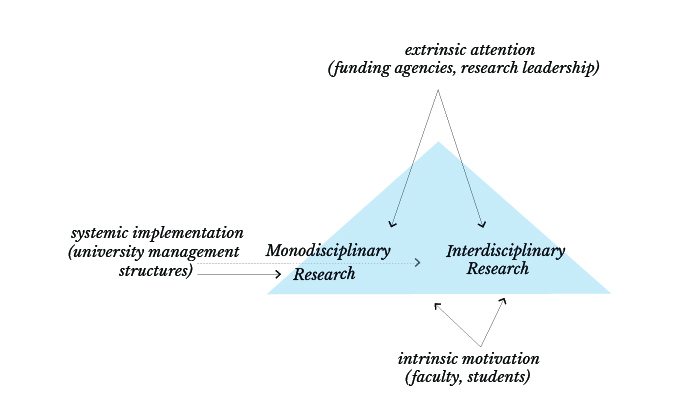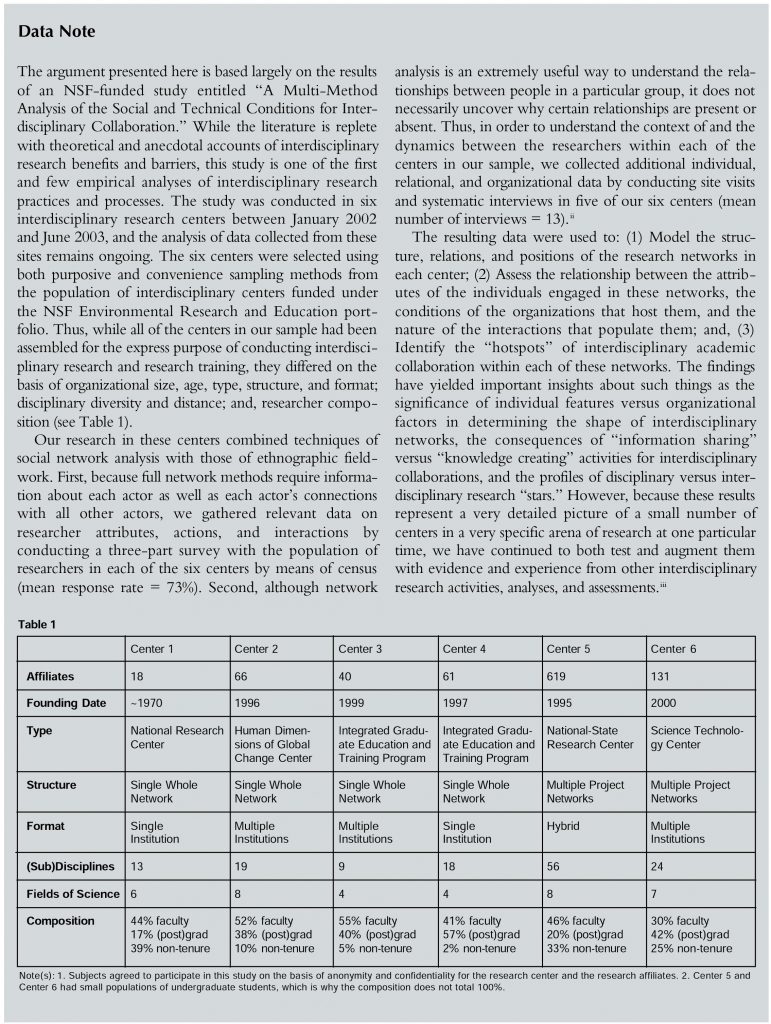“It took an ex-physicist—Francis Crick—and a former ornithology student—James Watson—to crack the secret of life. They shared a certain wanderlust, an indifference to boundaries.”
Robert Wright in TIME magazine 1  Wright, Robert. “Molecular Biologists Watson & Crick.” TIME 29 Mar. 1999: Vol. 153 No. 12. More info →
Wright, Robert. “Molecular Biologists Watson & Crick.” TIME 29 Mar. 1999: Vol. 153 No. 12. More info →
E.O. Wilson has argued that consilience—the “jumping together of knowledge” across disciplines “to create a common groundwork of explanation”—is the most promising path to scientific advancement, intellectual adventure, and human awareness.2  New York: Knopf, 1998.More info → Wilson and other interdisciplinary advocates contend that the breaching of scientific boundaries will lead to other breakthroughs as critical as the cracking of the DNA code.
New York: Knopf, 1998.More info → Wilson and other interdisciplinary advocates contend that the breaching of scientific boundaries will lead to other breakthroughs as critical as the cracking of the DNA code.
Today, some analysts claim that academic science has already embraced the idea of consilience and that a transformation is well underway from the traditional manner of doing research—homogeneous, disciplinary, hierarchical—to a new approach that is heterogeneous, interdisciplinary, horizontal, and fluid.3For example, see
→ Cooke, P. 1998. “Introduction: The Origins of the Concept.” In H. Braczik, P. Cooke, & M. Heidenreich (Eds.), Regional Innovation Systems: The Role of Governances in a Globalized World. London, England: UCL Press.
→ Etzkowitz, H. and L. Leydesdorff. 1998. “A Triple Helix of University- Industry-Government Relations: Introduction.” Industry & Higher Education 12 (4): 197-258.
→ Gibbons, M. et al. 1994. The New Production of Knowledge: The Dynamics of Science and Research in Contemporary Societies. London: Sage Publications. Others, however, suggest that the university’s metamorphosis toward interdisciplinarity 4We use interdisciplinarity here to refer specifically to the integration of different methods and concepts through a cooperative effort by a team of investigators. We do not use the term to refer to simply the representation of different disciplines on a team nor to individuals who may themselves incorporate different disciplines on a project themselves. is nowhere as far along as those in the first camp maintain.5For example, see
→ Hakala, J. and O-H. Ylijoki. 2001. “Research for Whom?” Organization 8 (2): 373-380.
→ Hicks, D. and J. Katz. 1996. “Where is Science Going?” Science Technology and Human Values 21: 379-406.
→ Slaughter, S. and L. Leslie. 1997. Academic Capitalism: Politics, Policies and the Entrepreneurial University. Baltimore: Johns Hopkins University Press. In fact, some would even argue that there is no empirical evidence of any fundamental change encompassing the university science system.6For example, see
→ Shinn, T. 1999. “Change or Mutation? Reflections on the Foundations of Contemporary Science.” Social Science Information 38: 149-176.
→ Weingart, P. 1997. “From ‘Finalization’ to ‘Mode 2’: Old Wine in New Bottles?” Social Science Information 36: 591-613.
“Many initiatives deemed interdisciplinary are, in fact, merely reconfigurations of old studies.”
Our recent NSF-funded study of interdisciplinary research centers and programs suggests that the latter camp is right to be skeptical. Across the spectrum of higher education, many initiatives deemed interdisciplinary are, in fact, merely reconfigurations of old studies—traditional modes of work patched together under a new label—rather than actual reconceptualizations and reorganizations of new research. It was common to hear, for example, the mechanical engineer, atmospheric physicist, and public policy analyst describing themselves as “coinvestigators on an interdisciplinary project” yet to observe them conducting their respective pieces of the research in near isolation from one another. Conversely, it was rare to encounter the hydrologist, economist, ecologist, and decision manager “collaborating directly with one another in the field” to formulate a new multi-objective integrative model.
Conventional explanations of the failures of interdisciplinary research to gain traction in the academy typically cite the following factors: the lack of funding for such initiatives; the indifference or hostility of scientists to working across established boundaries; and the incompatibility of university incentive and reward structures with interdisciplinary practices.7For example, see
→ Bohen, S. and J. Stiles. 1998. “Experimenting with Models of Faculty Collaboration: Factors that Promote Their Success.” In S. Frost (Ed.), Using Teams in Higher Education: Cultural Foundations for Productive Change. San Francisco: Jossey-Bass Publishers.
→ Klein, J. 1999. Mapping Interdisciplinary Studies. The Academy in Transition. Washington, DC: Association of American Colleges and Universities.
→ Metzger, N. and R. Zare. 1999. “Science Policy: Interdisciplinary Research: From Belief to Reality.” Science 283: 642-3.
→ National Academies—Institute of Medicine. 2000. Bridging Disciplines in the Brain, Behavioral and Clinical Sciences. Washington, DC: National Academy Press.
→ National Academies—National Research Council. 1987. Interdisciplinary Research in Mathematics, Science, and Technology Education. Washington, DC: National Academy Press.
→ Weingart, P. 1997. “From ‘Finalization’ to ‘Mode 2’: Old Wine in New Bottles?” Social Science Information 36: 591-613. While these explanations are not wrong per se, our research suggests that the first two claims may be overstated while the third actually underestimates the broader set and deeper source of organizational misalignments.
By adapting Huy and Mintzberg’s “triangle of change” 8 Huy, Q. and H. Mintzberg. 2003. “The Rhythm of Change.” MIT Sloan Management Review 44 (4): 79-84.More info → and applying it to the academic research environment, this article demonstrates that the transition to interdisciplinarity and consilience does not suffer from a lack of extrinsic attention at the “top” or intrinsic motivation at the “bottom,” but, rather, from a lack of systemic implementation in the “middle” (see figure below).

The fact is, universities have tended to approach interdisicplinarity as a trend rather than a real transition and to thus undertake their interdisciplinary efforts in a piecemeal, incoherent, catch-as-catch-can fashion rather than approaching them as comprehensive, root-and-branch reforms. As a result, the ample monies devoted to the cause of interdisciplinarity, and the ample energies of scientists directed toward its goals, have accomplished far less than they could, or should, have.
Extrinsic attention
In our ongoing study, we have found substantial evidence of extrinsic attention to interdisciplinary research in the discourses and resources of government agencies, policymakers, scholarly associations, and university administrators. We hear, for example, government officials such as Dr. Elias Zerhouni (Director, the National Institutes of Health) and Dr. Rita Colwell (Director, National Science Foundation)—the two largest federal funders of academic research—arguing that “disciplinary ‘silos’ need to broken” and “interdisciplinary connections are absolutely fundamental [as] the interfaces of the sciences are where the excitement will be the most intense.” We also see the National Academies as well as individual national scholarly associations—from the American Geophysical Union and the American Chemical Society to the American Institute for Biological Sciences and the American Political Science Association—sponsoring interdisciplinary analyses and emphasizing interdisciplinary activities at the borders of their represented sciences and disciplines. And, we find academic institutions from Harvard to Haverford proclaiming “the need for academic and interdisciplinary change and innovation” to “foster and enable collaboration among the faculties . . . to advance understanding of complex problems.” 9 Unfortunately, neither of the these institutions have this wording available on their websites any longer.
There are also increasing public monies being dedicated to interdisciplinary research. Of the $4.11 billion that the NSF requested from Congress for research and related activities in 2004, $765 million—a 16.5 percent increase over 2003—has been earmarked for four priority areas, all designated as interdisciplinary: Biocomplexity in the Environment, Information Technology Research, Nanoscale Science and Engineering, and Human and Social Dynamics.10See also
→ Society for Industrial and Applied Mathematics. 2003. “U.S. Federal Budget Update.” SIAM News 36 (2). Likewise, the NIH has budgeted $130 million in fiscal 2004, with more than $2.1 billion scheduled over the next five years, for the new NIH Roadmap, which stresses establishment of interdisciplinary training programs, research centers, and collaborative conferences.11 See
→ Morrisey, S. 2003. “Roadmap Charts NIH Course.” Chemical and Engineering News 81 (30).
“Private dollars are also being poured into interdisciplinary endeavors at unprecedented levels.”
In addition, private dollars are also being poured into interdisciplinary endeavors at unprecedented levels. In April 2003, the W. M. Keck Foundation underwrote a $40 million, 15-year grant to the US National Academies for the “National Academies Keck Futures Initiative,” a new program created to “stimulate new modes of inquiry and break down the conceptual and institutional barriers to interdisciplinary research.” In October of the same year, the James H. Clark Center opened as the new home of the Stanford University Bio-X Program, which is designed to accelerate interdisciplinary research for high-tech innovation in the biosciences. This center was funded largely by a $90 million grant from Clark (a well-known Silicon Valley entrepreneur) along with millions more from Atlantic Philanthropies. And, while operations won’t begin until 2006, the construction of the new Janelia Farm Research Campus was launched in late 2002. Speculated to cost $500 million and funded entirely by the Howard Hughes Medical Institute, the focus of Janelia Farm will be on “collaborative research that calls for the development and interdisciplinary application of cutting-edge technological tools [with] originality, creativity and a high degree of scientific risk-taking.”
Intrinsic motivation
According to Peter Weingart, interdisciplinarity, transdisciplinarity, and their inclusive kin have been “proclaimed, demanded, hailed, and written into funding programs” for more than thirty years, while at the same time specialization has increased at an exponential rate amongst researchers.12Weingart, P. 1997. “From ‘Finalization’ to ‘Mode 2’: Old Wine in New Bottles?” Social Science Information 36: 591-613. While that may be true, we found more tension than contradiction between a researcher’s institutional pressure to specialize and his/her intrinsic motivation to cross-fertilize.
In contrast to the often stereotypical portrait of stubborn, risk-averse scientists resistant to venture from their disciplinary safe houses, we encountered many researchers—particularly younger researchers—driven to the edges of their fields by a shift in their epistemological values and intellectual interests. It was not uncommon to hear statements such as:
I have become very aware of the horrible inefficiency of the scientific enterprise in turning knowledge into useful products and benefits . . . so I came [to this interdisciplinary center] to branch out from what I was doing, to do something bigger and better, more intellectually interesting and more practically important.
Or the chemical engineer who reported,
When I first started [my research], I was really scared. The last time I had taken a biology course was in eighth grade. But, the question I wanted to answer required biology. I needed to find a way to work at the interface of chemical engineering and microbiology, or I needed to find a different question . . . Now, I am sorta on the fringe of science, I guess, but I am dealing with the core problems of society. So, yeah, that is where I want to be.
In their analysis of twelve cross-disciplinary initiatives at Emory University, Susan Frost and colleagues found a similar migration toward interdisciplinary research, with researchers also reporting to be motivated by the prospect of “intellectual enrichment” and the sense of “intrinsic reward.”
The research affiliates in our study expressed this shift not only in their words but also in their actions and interactions. In the centers we surveyed, researchers reported committing on average about 50 percent of their total work time to center-related interdisciplinary activities. This is a substantial allocation of time given that interdisciplinary research is not always recognized as favorably or rewarded equally as compared to disciplinary research at the time of student and faculty evaluations. In fact, about 30 percent of researchers we surveyed reported that they felt their interdisciplinary affiliation had not helped and in some cases had even hindered their careers. For example, a graduate student in one center described his position as “non-traditional, highly beneficial, but completely risky,” while a postdoctoral fellow in another center confided that “part of me thinks I did a little bit of career suicide by coming here.”
“It is not surprising that, in the short-term, diversity will yield more creativity than productivity.” In addition to making significant interdisciplinary research commitments, researchers also report making substantial cross-disciplinary research connections by either sharing existing information through “collegial” interactions or together creating new knowledge via “close” interactions. According to our survey results, the average number of close and collegial connections that any one researcher has with other affiliates ranges from ten to fifteen (depending on the center), of which an average of between six and ten are with others outside his/her own discipline. Importantly, our data also indicate that while many of these connections—particularly those which cross disciplines—have yet to yield publications, 83 percent of the researchers surveyed said that their relationships with other center members have “positively” or “very positively” influenced the development of their own research agendas. It is not surprising that, in the short-term, diversity will yield more creativity than productivity, but it is significant as one begins to measure the “value” of interdisciplinary versus disciplinary science.No systemic implementation
If neither attention nor motivation are lacking in the pursuit of interdisciplinarity, what forces are preventing its promotion from trend to transition? We argue that despite “talking the talk” of cross-boundary collaboration, many universities are failing to “walk the walk.” Instead of implementing interdisciplinary approaches from the perspective of a thoroughgoing reform, many universities are simply adopting the interdisciplinary labels without adapting their disciplinary artifacts. The result has been problematic on two levels. Not only has the persistence of old structures created real or perceived disincentives to and penalties for pursuing interdisciplinary work. But, far more critically, the lack of systemic implementation taken in order to redesign and not just rename these structures and thus actively support interdisciplinary research has actually created initiatives that are inherently incapable of achieving the very goals they seek to accomplish and unfortunately unable to serve the very constituents they hope to support. Below are just a few cursory examples of some of the common organizational errors that have resulted from the lack of vigorous thinking around interdisciplinarity.
The interdisciplinary centers we studied here, as well as most of those we have since observed, are organized around large catch-all themes such as “global climate change,” “environmental impacts,” or “sustainable resources.” Yet, they often lack unified and unifying problem definitions and project directions around which their researchers’ skills and ideas could coalesce. While purposefully broad themes allow a certain amount of disciplinary multiplicity, the absence of explicit, discrete targets of work—otherwise known as “boundary objects”13 Boundary objects are artifacts that are used by different groups but which, when they cross the boundaries between groups, may be interpreted differently. The notion of “boundary objects” was developed by S. L. Star, “The Structure of Ill-Structured Solutions: Heterogeneous Problem Solving, Boundary Objects and Distributed Artificial Intelligence,” in Huhns and Gaser, eds. Distributed Artificial Intelligence (Los Altos, CA: Morgan Kaufmann, 1989).
More info →—appears to complicate rather than catalyze communication and collaboration between the disciplines. As a result, most interdisciplinary research centers have a tendency to become a nexus of loosely connected individuals searching for intersections, as opposed to cohesive groups tackling well-defined problems. This result is more akin to the traditional department structure—minus the common ground—than it is an example of a new mode of knowledge production.
Similarly, most centers we examined began by creating a “laundry list” of affiliates and disciplines at the proposal stage, instead of selecting on the basis of the research problem and identifying what researchers might potentially contribute. In combination with a trend in interdisciplinary funding toward longer-term initiatives, this has meant that researchers—having been chosen to fill a nominal slot rather than address a specific role—often find themselves “locked in” to center affiliations from which they do not benefit professionally and may not even thrive intellectually despite their own motivations and interests. In several cases, researchers reported forsaking the extrinsic rewards for the intrinsic ones but in the end getting neither:
I was left with nothing but feelings of frustration and ambivalence with the interdisciplinary center, and feelings of fear and rejection in my disciplinary department.
Thus, while longer organizational life cycles may give centers time to improve their research practices and processes, long-term and full-time affiliations can actually limit and not accentuate researcher creativity and productivity. In our study, researchers who felt free to enter and exit collaborative relationships reported more progress with their interdisciplinary projects and greater satisfaction in their professional lives overall.
In the same vein, interdisciplinary centers seem to have associated larger numbers of affiliates with greater rates of interdisciplinarity. While this may make sense in terms of increasing disciplinary multiplicity, our data show that it does not increase meaningful interdisciplinary activity. In fact, our results suggest that although medium and large centers (twenty to forty-nine affiliates and fifty or more affiliates, respectively) may produce marginally more information-sharing relations within and across disciplines on average than small centers (fewer than twenty affiliates), they are not necessarily more effective at producing interdisciplinary knowledge–creating connections. Indeed, we found that small centers—or small bounded networks within large centers—actually produce more such connections than larger centers do.
“We must rely on cyber-infrastructure to support interdisciplinary science.” Moreover, because many large centers are interinstitutional or international, they must rely on cyber-infrastructure to support interdisciplinary science. While such technologies make long distance science collaborations plausible, the data indicate that technologically mediated communication may be a good complement but not a good substitute for face-to-face communication—particularly when working across different disciplines. Approximately 71 percent of the researchers in our study reported face-to-face communication as their primary mechanism for information sharing and knowledge creating, both in general and across disciplines. This compares to 59 percent who reported using technologically mediated communication in general, and only about 50 percent who employ technologically mediated communication across disciplines. Finally, the fact that 77 percent prefer informal to formal face-to-face communication in both circumstances reinforces other research suggesting that the sharing of scientific information and the creation of new knowledge are dependent on the interpersonal, spontaneous interactions of researchers 14 Kanfer, A. et al. 2000. “Modeling Distributed Knowledge Processes in Next Generation Multidisciplinary Alliances.” Information Systems Frontiers, Special Issue on Knowledge Management, 2 (3/4): 317-331.—a class of interaction generally hindered by traditional disciplinary departments and so often unrealized by new interdisciplinary centers.Some implications and conclusions
At the outset of our study, we were struck by how little empirical data existed about the real-world practice of interdisciplinary research. Two years later, we are struck by the fact that our data raise more questions than they answer. And yet, even so, we believe there are a number of clear implications to be drawn from our study regarding the future conduct of cross-boundary science.
To provide fertile ground for this type of research, interdisciplinary centers need not only to be well-funded, but to have an independent physical location and intellectual direction apart from traditional university departments. They should have clear and well-articulated organizing principles—be they problems, products, or projects—around which researchers can be chosen on the basis of their specific technical, methodological, or topical contributions, and to which the researchers are deeply committed. While a center should be established as a long-standing organizational body with continuity in management and leadership, its researchers should be appointed for flexible, intermittent, but intensive short-term stays that are dictated by the scientific needs of projects rather than administrative mandates. Not only will such rotating appointments allow researchers to satisfy their intellectual curiosities without jeopardizing their professional responsibilities, they will also better serve the epistemological priorities of interdisciplinary research.
As more researchers divide their time between interdisciplinary centers or programs and traditional disciplinary departments, the academic research community must learn to accommodate institutionally and professionally what Brown and Duguid 15  Boston: Harvard Business Review Press, 2000.Read the first chapter describe as “networks of practice.” Networks of practice constitute the broad social systems through which researchers share information but which do not always yield new knowledge in immediate or traditional forms. In the current academic structure, the value of research and researcher alike is usually measured by the production of new knowledge in the form of publications in academic journals. However, information sharing networks may often yield “harder to count” but equally important—albeit different—outputs such as Congressional testimonies, public policy initiatives, popular media placements, alternative journal publications, or long-term product developments. While these are the opportunities that often draw individuals to interdisciplinary work, they are also some of the most under-appreciated and unrewarded activities within today’s academy.
Boston: Harvard Business Review Press, 2000.Read the first chapter describe as “networks of practice.” Networks of practice constitute the broad social systems through which researchers share information but which do not always yield new knowledge in immediate or traditional forms. In the current academic structure, the value of research and researcher alike is usually measured by the production of new knowledge in the form of publications in academic journals. However, information sharing networks may often yield “harder to count” but equally important—albeit different—outputs such as Congressional testimonies, public policy initiatives, popular media placements, alternative journal publications, or long-term product developments. While these are the opportunities that often draw individuals to interdisciplinary work, they are also some of the most under-appreciated and unrewarded activities within today’s academy.
How best to support and encourage these new ways of learning is the central challenge now facing the academy. All around us, the sciences are increasingly colliding at the nexus of complex problems. In the years ahead, those collisions have the capacity to produce many interdisciplinary discoveries as seminal as Watson and Crick’s. The universities that successfully reform themselves to meet the challenges presented by interdisciplinary research will find themselves at the center of what some observers liken to a second scientific revolution. Those who fail will find themselves watching from the sidelines.
This study (BCS-0129573) was awarded by the National Science Foundation Biocomplexity in the Environment Program to Diana Rhoten, PhD and the Hybrid Vigor Institute. We would like to thank John Seely Brown for his insightful comments on preliminary drafts of this particular article and for his constantly stimulating conversation on the topic in general. We would also like to recognize Andrew Parker, whose technical contributions have made this project possible.
See “A Multi-method Analysis of the Social and Technical Conditions for Interdisciplinary Collaboration,” the final report of this study, here.
Diana Rhoten is currently a partner at IDEO. During her time at the SSRC, she was the director of the Program on Knowledge Institutions and Innovation. 16 The SSRC’s Program on Knowledge Institutions and Innovation was active from 2003 to 2008. The following is a description of the program:
“An array of technological, socio-political, and economic conditions are transforming the way scientific and societal knowledge is produced and disseminated. The emergence of collaborative technologies, the shifting influence of non-academic versus academic organizations and private versus public investments are challenging traditional institutions of education, training, and research. To understand this new knowledge ecology, the SSRC coordinates research on new models of organizational collaboration, emerging fields of research and changing forms of scholarship, transformations of higher education, transitions to college, and innovative programs in interdisciplinary and integrative training.”
This essay originally appeared in Items & Issues Vol. 5, Issue 1-2 in the summer of 2004. Visit our archives to view the original as it first appeared in the print editions of Items.
References:
 Wright, Robert. “Molecular Biologists Watson & Crick.” TIME 29 Mar. 1999: Vol. 153 No. 12. More info →
Wright, Robert. “Molecular Biologists Watson & Crick.” TIME 29 Mar. 1999: Vol. 153 No. 12. More info →→ Cooke, P. 1998. “Introduction: The Origins of the Concept.” In H. Braczik, P. Cooke, & M. Heidenreich (Eds.), Regional Innovation Systems: The Role of Governances in a Globalized World. London, England: UCL Press.
→ Etzkowitz, H. and L. Leydesdorff. 1998. “A Triple Helix of University- Industry-Government Relations: Introduction.” Industry & Higher Education 12 (4): 197-258.
→ Gibbons, M. et al. 1994. The New Production of Knowledge: The Dynamics of Science and Research in Contemporary Societies. London: Sage Publications.
→ Hakala, J. and O-H. Ylijoki. 2001. “Research for Whom?” Organization 8 (2): 373-380.
→ Hicks, D. and J. Katz. 1996. “Where is Science Going?” Science Technology and Human Values 21: 379-406.
→ Slaughter, S. and L. Leslie. 1997. Academic Capitalism: Politics, Policies and the Entrepreneurial University. Baltimore: Johns Hopkins University Press.
→ Shinn, T. 1999. “Change or Mutation? Reflections on the Foundations of Contemporary Science.” Social Science Information 38: 149-176.
→ Weingart, P. 1997. “From ‘Finalization’ to ‘Mode 2’: Old Wine in New Bottles?” Social Science Information 36: 591-613.
→ Bohen, S. and J. Stiles. 1998. “Experimenting with Models of Faculty Collaboration: Factors that Promote Their Success.” In S. Frost (Ed.), Using Teams in Higher Education: Cultural Foundations for Productive Change. San Francisco: Jossey-Bass Publishers.
→ Klein, J. 1999. Mapping Interdisciplinary Studies. The Academy in Transition. Washington, DC: Association of American Colleges and Universities.
→ Metzger, N. and R. Zare. 1999. “Science Policy: Interdisciplinary Research: From Belief to Reality.” Science 283: 642-3.
→ National Academies—Institute of Medicine. 2000. Bridging Disciplines in the Brain, Behavioral and Clinical Sciences. Washington, DC: National Academy Press.
→ National Academies—National Research Council. 1987. Interdisciplinary Research in Mathematics, Science, and Technology Education. Washington, DC: National Academy Press.
→ Weingart, P. 1997. “From ‘Finalization’ to ‘Mode 2’: Old Wine in New Bottles?” Social Science Information 36: 591-613.
→ Society for Industrial and Applied Mathematics. 2003. “U.S. Federal Budget Update.” SIAM News 36 (2).
→ Morrisey, S. 2003. “Roadmap Charts NIH Course.” Chemical and Engineering News 81 (30).
More info →
“An array of technological, socio-political, and economic conditions are transforming the way scientific and societal knowledge is produced and disseminated. The emergence of collaborative technologies, the shifting influence of non-academic versus academic organizations and private versus public investments are challenging traditional institutions of education, training, and research. To understand this new knowledge ecology, the SSRC coordinates research on new models of organizational collaboration, emerging fields of research and changing forms of scholarship, transformations of higher education, transitions to college, and innovative programs in interdisciplinary and integrative training.”














